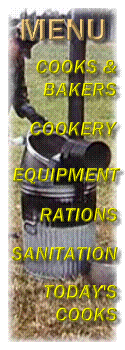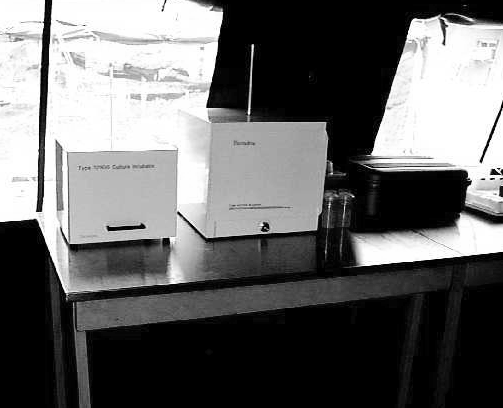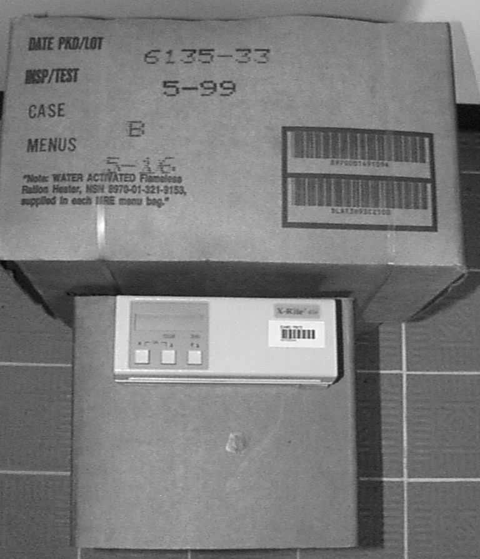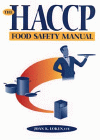
Food Safety Diagnostics
Ensuring Safe Food for Soldiers
The United States has the safest food supply in the world. Because various regulatory agencies continuously monitor food safety, Americans take the safety of their food for granted. Still, each year up to 81 million Americans suffer food-borne illnesses, and 9,100 die.
U.S. troops are deployed worldwide to places where commercial food sanitation standards may be inferior and enforcement of those standards may be less than optimal. Food-borne disease outbreaks are a significant threat to our deployed fighting forces, capable of incapacitating many troops at any given moment. This is a risk the Army cannot afford to take. The Army Veterinary Service must do all it can to conserve the Army's fighting strength through an active food-safety surveillance program. Americans expect safe, high-quality food, and U.S. military personnel expect no less.
Having soldiers consume only operational rations in a theater of operations would minimize the threat of a food-borne outbreak. However, consuming only operational rations without class A (freshly prepared food) supplementation would create a serious morale problem with deployed troops. Therefore, field commanders want to maximize the availability of freshly prepared meals. Class A rations, particularly locally procured food items, present the highest danger as a source of food-borne diseases.
In the past, Army food inspectors were unable to ensure food safety in a field environment because portable diagnostics were not available. They based their food-safety efforts on sanitary inspections of food establishments and periodic tests of food in a centralized laboratory. Installation-level veterinary inspection programs sought to identify food quality problems. However, recently developed commercial technology allows for rapid, presumptive screening of high-risk food for bacterial pathogens, spoilage organisms, and pesticides in the field before it is served to soldiers. The 18th Medical Command Veterinary Services, part of U.S. Forces Korea (USFK), is using this technology to ensure that the food we provide to soldiers during peacetime is safe. This technology also will permit high-risk foods to be screened on the battlefield.
The position of the 18th Medical Command Veterinary Services is that to ensure a safe food supply in a forward deployed theater, rapid food-safety laboratory diagnostics must be used.
Food-borne disease threats
The majority of food-borne disease outbreaks result from unintentional contamination of a product as a result of inappropriate processing or handling. Outbreaks caused by substandard sanitation or improper food handling are well documented. In 1985, an estimated 350 school children and staff at a Georgia elementary school developed febrile gastroenteritis associated with the bacteria Salmonella enteriditis. The food source was identified as turkey salad that had been refrigerated improperly before it was served. In 1997, the largest beef recall in history occurred as a result of Escherichia coli bacteria-contaminated ground beef processed by Hudson Foods of Columbus, Nebraska. The extent and swiftness of this recall resulted in less than 20 illnesses, compared to the Jack-In-The-Box fast-food restaurant outbreak in 1993 that resulted in over 700 illnesses and several deaths. In 1996, a large food-borne disease outbreak occurred in Japan, causing more than 5,000 illnesses and 6 deaths—primarily among schoolchildren. School lunches contaminated with E. coli bacteria were identified as the source.
Intentional contamination of our food supply with biological or chemical agents also is a significant threat. Bioterrorist attacks on our food supply could be covert or announced and could be accomplished with selected bacterial pathogens or toxins. The United States actually experienced one such attack in 1984. In The Dalles, Oregon, a religious cult contaminated 10 salad bars in restaurants with the incapacitating bacteria Salmonella typhimurium on Election Day to influence the results of county elections. Within 1 month, over 750 cases of Salmonella typhimurium were diagnosed. It took more than 2 years of diagnostic effort to determine that this food-borne outbreak was intentional. Similar intentional acts of bioterrorism against U.S. forces are a real threat and could be difficult to detect without an active food-safety surveillance program.
The Charm Sciences, Inc., Lum-T is an instrument used to complete several diagnostics, such as sanitation validation, fluid dairy shelf-life prediction assay, and pesticide assay.
U.S. Government initiatives
|
|
| The Charm Sciences, Inc., Lum-T is an instrument used to complete several diagnostics, such as sanitation validation, fluid dairy shelf-life prediction assay, and pesticide assay. |
President Clinton's fiscal year (FY) 1999 budget requested $101 million to improve the safety of the Nation's food supply. The request included an increase in research to develop new tests to detect food-borne pathogens and assess risks to the food supply. Further, the President's FY 2000 budget includes a $144 million request for the Department of Health and Human Serv-ices for "bioterrorism preparedness."
A key step in establishing an effective food-safety program in a forward-deployed theater is to have adequate laboratory diagnostics that can identify and characterize rapidly any agent that could cause a food-borne disease outbreak. Within the 18th Medical Command, food-safety efforts have focused on monitoring potentially hazardous foods as they move through the supply system. To enhance current USFK food-safety and -quality programs, the veterinary services decided to use commercial rapid-screening food laboratory diagnostics. Some capabilities of these diagnostics include:
-
Microbiology testing of both liquid and solid foods.
-
Food surface sanitation validation.
-
Dairy product shelf-life prediction testing.
-
Pesticide analysis of fresh fruits and vegetables.
-
Continuous internal product temperature monitoring of perishable food while in transit.
Commercial rapid food-safety diagnostics have been procured and deployed throughout the Republic of Korea as an integral part of our active food-safety surveillance program. The immediate availability of laboratory data at key food distribution points within the Republic of Korea ensures that all USFK personnel have safe, high-quality food.
Commercial rapid food-safety diagnostics
Today's consumers demand safe food. The commercial food industry's ability to identify bacterial pathogens and unsafe residues has resulted in an almost fivefold increase in food recalls by major manufacturers since 1988. New technology allows Government regulatory agencies to identify a bacterial pathogen and trace it back to its source more rapidly. The key to this new technology is the availability of rapid food-safety diagnostics.
These rapid food-safety diagnostics provide a quick, "positive or negative" answer before the food product enters the distribution system. Tests take up to 30 hours to complete because of the requirement for a bacterial growth enrichment period. This growth enrichment period is necessary to increase the total number of bacteria so they can be detected using current technology. A negative answer means that the product does not contain that particular bacteria or toxin and no further testing is required. A positive answer means that further testing is needed at a reference laboratory using standard laboratory methods to confirm the actual presence of the bacteria or toxin. For example, rapid screening for Salmonella typhimurium requires approximately 24 hours to complete. To confirm the existence of this organism, standard laboratory methods of isolation for 96 to 120 hours must be used.
USFK food-safety diagnostic capabilities
The 18th Medical Command Veterinary Laboratory has the following rapid food microbiology capabilities:
-
Prepared growth media. Petrifilm Plates, developed by 3M, provide standard bacterial plate counts, total gram-negative coliform counts (indicating fecal contamination), and yeast/mold counts on fluid products. Pathogel, developed by Charm Sciences, Inc., detects the presence of E. coli and Salmonella.
-
Blenders. The Stomacher Laboratory Blender, manufactured by Seward Ltd. of London, England, is used to conduct microbiological testing on solid food products. The Stomacher blender emulsifies the product in a buffer solution from which we draw sterile liquid aliquots (samples) for microbiological testing.
 |
| This photo shows a portable food microbiology lab in a field environment. |
-
Portable rapid diagnostic kits. USFK is procuring these kits to screen for bacterial pathogens and toxins such as E. coli, Bacillus cereus, Listeria monocytogenes, and Staphyloccocal enterotoxin B. With these kits, most results can be obtained in 24 to 48 hours. There are two very important benefits of this capability: the kits eliminate the delay caused by obtaining routine results from a stateside laboratory, and they are 100 percent transportable to support class I
(subsistence) operations in the field. -
Polymerase chain reaction (PCR) technology. This is "DNA fingerprinting" technology that can identify a specific bacterial genus and species. This will overcome the inability of rapid microbiology diagnostics to identify specific bacterial organisms (by genus and species). Unfortunately, the current PCR equipment is not field transportable and requires a fixed laboratory. However, the Air Force Force Protection Battlelab at Lackland Air Force Base, Texas, is testing a field portable PCR system made by Idaho Technology, Inc.
-
Surface sanitation test. Another aspect of food safety includes monitoring the cleanliness and sanitation of food contact surfaces. This is extremely important in contract dining facilities that employ personnel from developing countries to handle and prepare food. All efforts to ensure that food is safe while in the supply system can be defeated by improper handling and preparation. The PocketSwab (available from Charm Sciences, Inc.) is a self-contained swab designed to determine the effectiveness of cleaning and sanitizing food contact surfaces by measuring adenosine triphosphate (ATP) levels. ATP levels indicate the organic matter present on a surface, which potentially can support bacterial growth. A properly cleaned and sanitized surface will have very low levels of ATP (less than 5,000). When ATP levels are very high (more than 100,000), the surface is unacceptable. These extremely high ATP levels are commonly associated with the presence of bacteria, either pathogenic or spoilage. The PocketSwab allows us to obtain quantifiable numbers to ensure that food contact surfaces are clean and sanitized before processing any food. This reduces the possibility of food being contaminated while it is being prepared.
-
Pesticide test. The Charm Pesticide Assay (by Charm Sciences, Inc.) can screen locally purchased fresh fruits and vegetables for pesticides in 20 minutes. Since many nerve agents are organophosphates, this technology has the potential for detecting a nerve agent in chemically contaminated rations. To do this, specific tests must be developed for each nerve agent.
-
Temperature-monitoring devices. Temperature damage, either in transit or in storage, always has been a danger for perishable foods. Our ability to monitor the extent of damage resulting from a refrigeration failure always has been very subjective. The MonitorMark (by 3M) is a temperature-sensitive strip that turns blue if the temperature exceeds 40 degrees Fahrenheit. In instances where severe temperature damage occurs, such as at 70 degrees Fahrenheit, the strip turns blue more rapidly. It does not determine when the abuse occurred or its extent, but it alerts the user that temperature damage of the product has occurred. This is an inexpensive means of monitoring chilled food shipments (which should be kept at 34 to 40 degrees Fahrenheit). An even better way to monitor product temperature is with the Sensitech TempTale. The TempTale is a computer chip temperature-monitoring device that can screen internal product temperature continuously, record over 2,000 temperature readings, and provide data analysis when downloaded into a
computer. The data analysis feature enables the food inspector to determine the extent of temperature damage to a particular product and make instantaneous decisions on its disposition. For example, if a shipment is received and there was no temperature damage, the product will be issued normally. If a temperature abuse in transit is documented, that product will be priority-issued before its quality deteriorates further. In conjunction with temperature monitoring, routine food microbiology surveillance also is being conducted to determine the level of spoilage bacteria present, as well as to ensure the absence of pathogenic bacteria.
 |
| A densitometer is used for measuring optical densities on time temperature indicators (TTI's) on MRE cases. The patch in the center of the case is a TTI. |
-
Time temperature indicator (TTI). The Fresh-Check TTI, from LifeLines Technology, Inc., is designed as a visual aid in determining the extent of temperature abuse in meals, ready to eat (MRE's). It is designed to change colors at the 50- to 100-degree Fahrenheit range. Visual reading to determine color changes of the TTI is arbitrary, depending on the skill and experience of the inspector. We have eliminated this variable by using a densitometer.
-
Densitometer. A densitometer is an optical density-measuring device that provides the user with a specific optical density reading of the TTI. LifeLines Technology, Inc., also has developed a chart with optical density readings that correspond to the remaining MRE shelf life at various storage temperatures. MRE shelf life is temperature dependent. The inspection test date printed on each case is designed for a storage condition of 80 degrees Fahrenheit for 3 years. MRE's stored at 60 degrees Fahrenheit will have a much longer shelf life than MRE's stored at 90 degrees. This technology aids in assessing unit-level MRE storage conditions without an on-site visit. The ability to determine the remaining shelf life without opening the packages will result in a cost savings to the logistics community.
-
Fluid dairy shelf-life validation/prediction assay. Combined with microbiology screening tests, this test, developed by Charm Sciences, Inc., is used routinely by Army food inspectors to determine the shelf life of extended-shelf-life (ESL) milk. This milk has a 70- to 90-day shelf life and requires refrigeration. ESL milk can be stored beyond this period if it meets safety and quality standards. A qualitative assay will detect increases in microbial ATP, which correlate with the presence of spoilage or pathogenic bacteria before any visible changes are seen in the milk. This enables the inspector to advise the logistician to priority-issue a product before it becomes unacceptable. The result is still a high-quality, safe product for soldiers and their families. Similarly, an assay also can be used to extend expiration dates beyond those on the label.
Future
The threat of weapons of mass destruction is very real. One concern that faces the U.S. Government daily is bioterrorism. Kits
for detecting chemical agents in water are well developed and effective. However, our ability to detect chemical and biological
agents in food is very limited. Majesco Biologics and the Army Soldier and Biological Chemical Command in Natick,
Massachusetts, working independently, are developing biosensor technology to identify bacterial pathogens and toxins in only
15 to 30 minutes by eliminating the requirement for a 24-hour bacterial enrichment phase. This new technology is extremely
sensitive and can detect much lower levels of bacteria and toxins than current rapid diagnostics can. Although fielding of
biosensor technology is 2 to 3 years away, these advances should be adopted by the Army Veterinary Service to maintain an
effective food-safety surveillance program.
This proactive approach to food safety and bioterrorism prevention does not agree with a White Paper published recently by the Office of the Surgeon General entitled "The Vulnerability of the DOD Food Supply to Chemical/Biological Terrorism—The Role of the Army Veterinary Service." This paper advocated a post-epidemiological investigation to determine the source of a biological agent attack. The authors stated that the use of current surveillance technology was too expensive and too manpower intensive. Admittedly, no surveillance system can be 100-percent accurate. In the event of a food-borne disease outbreak, intentional or unintentional, faster identification and characterization of the agent will aid in the medical treatment of those affected. It also will help our medical personnel determine if exposed but asymptomatic personnel require prophylactic treatment. It is the 18th Medical Command Veterinary Services' position that having the capability to screen routinely for select bacterial pathogens and toxins would be a deterrent to bioterrorism.
In support of the Army Medical Department's Medical Reengineering Initiative to redesign its combat health support units, the Army Veterinary Service has developed a food procurement detachment with a portable food microbiology capability. This capability emphasizes rapid food-safety diagnostics in division rear and corps and echelons-above-corps areas of operations. Fielding is scheduled for fiscal year 2002 in the Republic of Korea.
In my opinion, there does not appear to be a collaborative effort between commercial industry and military research laboratories. However, it is encouraging that various Government agencies, such as the Army Soldier and Biological Chemical Command, are developing biosensor technology. Technology continues to improve at a very rapid pace; equipment that is state-of-the-art today may not be tomorrow. Therefore, the contents of the field food microbiology set will be an ongoing evolution. As one item becomes obsolete, it will be replaced by the newest off-the-shelf technology. This new technology will not be intended solely for field use but will be part of our ongoing, active food-safety surveillance program during peacetime.
Natural food-borne outbreaks and bioterrorism will continue to occur worldwide. An active food-safety surveillance program that conducts rapid, presumptive laboratory testing helps to ensure a safe food supply. Our goal is to provide food inspectors with real-time laboratory data for making on-the-spot recommendations concerning food safety and quality. Making use of available commercial technology is the easiest and most efficient way to achieve this goal.
Capt. John C. Beach currently is pursuing a master of science degree in food microbiology at Texas A&M University. He was the chief of U.S. Forces Korea Food Safety in Yongsan, South Korea, when he wrote this article. Capt. Beach has a doctor of veterinary medicine degree from Oklahoma State University and is a graduate of the Army Medical Department Officer Advanced Course.
An Army Logistician story from the May-June 2000 issue.
May 2000
| Bulletin Board | Keyword Search |
| Bookstore | Links |
| About Us | Recent Additions |


